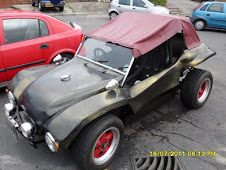 After reeling from my engine case problems which occured when I was overhauling the original engine crankcase. I soon realised that there really was no way that the existing case could have been bored out to 94mm to accept the new barrels and pistons I had purchased. The main reason for this was that the 1300 box used adapters to hold the 8mm heads into the crankcase These adapters are know as case savers and where fitted to the later engines. These would have not allowed the cylinders to be bored out without cutting into these threads. This would therefore have not worked. Fortunately my original case had developed problems when I taped the oil gantries out to take the brass plugs. One of the 1/8NPT plugs under the fly wheel had split the case rendering it unusable. I am presuming that there was a fracture in the case prior to me cutting the thread that had spit when I used the extracter to remove the brass plug.
After reeling from my engine case problems which occured when I was overhauling the original engine crankcase. I soon realised that there really was no way that the existing case could have been bored out to 94mm to accept the new barrels and pistons I had purchased. The main reason for this was that the 1300 box used adapters to hold the 8mm heads into the crankcase These adapters are know as case savers and where fitted to the later engines. These would have not allowed the cylinders to be bored out without cutting into these threads. This would therefore have not worked. Fortunately my original case had developed problems when I taped the oil gantries out to take the brass plugs. One of the 1/8NPT plugs under the fly wheel had split the case rendering it unusable. I am presuming that there was a fracture in the case prior to me cutting the thread that had spit when I used the extracter to remove the brass plug.I managed to find a replacement crankcase on VZi from a gentleman in the other side of Brighton. Luckily the new crank case had been bored out to 94mm already and was already machined for full flow oil. The full flow oil process requires that the outlet of the oil pump be threaded and a plug screwed in and the main oil return be taped with a 3/8NPT tap. Generally speaking the new case was in good condition and had never been line bored as it was 64mm on the main bearings.
I decided that as i did not know the condition of the oil gantries that i would have to tap them. I started by removing the pressure valves. These are located on the bottom of the case at the front and back of the engine. The pressure valves and springs are covered by a screw in plug that has a large screw driver slot in its top. The easiest way to get these undone is to tap the right side of the slot with a screw driver and hammer , so using them as a punch to knock the cap undone. With the caps removed the springs can be removed giving access to the pistons. These are usually pressed tight up into the engine. I use a piece of cane that I cut down to gain the correct width to just fit into the piston. Once you have the right diameter you can knock this into the piston so that you can twist the piston out and ease the cane and piston out.
The gantry caps could then be removed from the case. I used a 1/8 drill to drill the centre of the caps and a wood screw turned into the cap until it was firm enough to
 allow a claw hammer to pull the screw and the cap out together. The exposed gantries could then be drilled and taped with their respective threads 1/8NPT, 1/4NPT and 3/8NPT. There are four 1/8NPT holes that need to be drilled out to 11/32". The two 1/4NPT threads can be taped straight into the gantry as the hole is already the correct size. The two 38NPT threads require the gantry hole to be drilled out to 9/16" before they can be taped. Generally speaking you need to drill the hole a bot longer than the length of your plug. I found that when taping the threads it was better to start the thread with a taper tap. I cut down a second taper tap to make a plug that was the same length of the screw plug that I was using. With the used together I was able to get the plugs to seat below the level of the casing.
allow a claw hammer to pull the screw and the cap out together. The exposed gantries could then be drilled and taped with their respective threads 1/8NPT, 1/4NPT and 3/8NPT. There are four 1/8NPT holes that need to be drilled out to 11/32". The two 1/4NPT threads can be taped straight into the gantry as the hole is already the correct size. The two 38NPT threads require the gantry hole to be drilled out to 9/16" before they can be taped. Generally speaking you need to drill the hole a bot longer than the length of your plug. I found that when taping the threads it was better to start the thread with a taper tap. I cut down a second taper tap to make a plug that was the same length of the screw plug that I was using. With the used together I was able to get the plugs to seat below the level of the casing.Once I had taped and cleaned out the gantries I decided I would like to get the case media blasted to bring back its surface to look like new.
I also found out via a friend that as I was building a large engine I would probably be best to locate a new balanced forged crankshaft although I hadnt figured this into my budget I new that if my existing crank failed it would damage all the other components around it and so was really not worth the risk.






















No comments:
Post a Comment